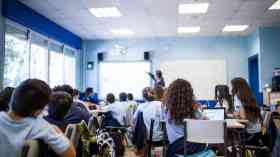
The positives and negatives of computing
Increasing numbers of schools are offering computer science at GCSE and A-Level, however, relatively few students choose to take the subject. These are the findings from the Roehampton Annual Computing Education report. Education Business explores the report further
Computing as a subject was introduced into the curriculum in England in 2014. Numbers taking it have grown steadily, and 2017 saw 67,000 students sit the Computer Science (CS) GCSE. However, there are still areas of concern surrounding the subject.
While increasing numbers of schools are offering computer science at GCSE (52.5 per cent) and A level (36.2 per cent), relatively few students choose to take the subject. These are the findings from the Roehampton Annual Computing Education report, by the University of Roehampton.
It analysed the uptake of computing and computer science qualifications at GCSE and A-level by looking at the schools that offered the qualifications and the students sitting them in 2017.
Although numbers taking the subject continue to rise, the report finds that relatively few students choose to take the Computer Science – 11.9 per cent at GCSE and just 2.7 per cent at A-Level.
Patchy provision
Provision of computer science remains ‘patchy’. Grammar schools are more likely than comprehensives to offer the subject, with independent schools rather less so. What’s more, there are differences among local authorities and multi-academy trusts, with some leading the way, and others lagging behind.
At GCSE, the typical CS student is academically strong, mathematically able, likely to be taking triple science, from a relatively affluent family, and overwhelming likely to be male, the report finds.
Girls continue to be heavily underrepresented. At GCSE 20 per cent of entries are from female students and only 10 per cent at A-level, even though girls do better than boys at GCSE. There were 25 local authorities with A-level CS provision but no female participation. Some schools and local authorities are doing well in addressing the gender gap in CS, but there are 382 mixed schools where the CS students are all boys.
A niche subject
The report finds that A-level CS remains a niche subject. Students typically have good maths grades, but their overall academic performance is not strong.
CS is often taken in combination with maths and physics. Again, students are likely to come from relatively affluent backgrounds, but rather more of these students will be on the school’s SEN register than for most subjects.
CS and ICT are quite different qualifications, and therefore taken by quite different students. ICT participants are (on average) from less affluent backgrounds, weaker academically, closer to a typical mix for ethnicity, and more likely to be female. Therefore, the decision to remove ICT as qualifications at GCSE and A level seems likely to result in fewer and rather less diverse students overall taking qualifications in computing.
The study also concluded that GCSE and A level computer science are hard. At GCSE, students typically get half a grade lower in CS than in their other subjects; at A level, CS grades are also a little lower (about a sixth of a grade) than those students get for their other subjects.
Geographic provision
There is substantial variation in GCSE Computer Science provision between English regions. In particular London (49.2 per cent) and the West Midlands (47.3 per cent) see the lowest percentage of providers offering the subject, compared to 55.3 per cent of providers in North West. Uptake ranges from 13 per cent in the North West to 10.2 per cent in Yorkshire and the Humber.
There are some excellent examples of GCSE CS provision and uptake across the country with Bournemouth, Knowsley, Trafford and Hartlepool local authorities (LAs) having more than one in five of their students studying the subject.
However, schools in many local authorities still have a lot of work to do, with low uptake amongst several local authorities, e.g. Kingston upon Hull (3.9 per cent) and Luton (5.1 per cent).
Recommendations
The report findings have lead the authors of the report to call for an urgent inquiry into the long-term impact the removal of ICT will have on the digital education of young people.
In particular, the analysis should examine if the current suite of available qualifications is truly inclusive and of benefit to all children.
They believe there is a need for clarity on vocational qualifications and a need for a replacement for the ICT GCSE and A-level, or a ‘single subject’ computing GCSE that encompasses the CS, IT and digital literacy elements.
The report also highlights the need to grow the numbers of students sitting the subject.
Most providers appear to be only offering one class of computer science provision; schools should be encouraged to enter a wider ability range of students into the subject. This will of course require that there are enough qualified teachers to deliver the subject.
There also needs to be continued effort to address the gender gap in computing participation. Given girls are generally better represented when taking digitally ‘creative’ courses, compared to computer science, the report authors call for research to explore the concept of ‘creative computing’, in which computer science might be combined with creative work in a range of digital media.
Furthermore, we found there are areas in which female uptake is good; the reasons for this engagement need to be explored, with the lessons learned widely shared.
The report also says that the reasons for the differences in CS participation from students across social and ethnic backgrounds needs to be investigated, and that discussions around inclusion in computing must include other factors in addition to gender.
A-level CS students are more likely to be receiving SEN support than other students taking an A-level, including their peers taking ICT or physics.
Research is needed into the functioning profiles of those classified as having special educational needs and taking computer science, their reasoning for taking the subject and their performance in CS.
The report also recommends looking at size classes, as the authors are concerned about the viability of small class sizes in computing. Given the small cohort sizes of A-level computer science providers, there is a need to review the sustainability of CS at A-level.
Rise to the challenge
The report states: “Overall, these findings suggest that we now must rise to the challenge of encouraging (or perhaps allowing) more students to have a go at CS, learning from the good practice in schools, local authorities and trusts that are already succeeding here. This issue is particularly acute at A level, where less than 15 per cent of colleges or sixth forms have cohorts that the DfE would regard as viable.”
The authors of the report said they welcomed the introduction of computer science into the curriculum but they now believe ICT should be retained as an alternative.
“The government’s refusal to renew GCSE and A-level IT, against the will of the teaching community, is making computing more exclusive,” says Peter Kemp from the University of Roehampton.
“The overemphasis on computer science seems likely to lead to fewer students, particularly girls, studying any digital qualification at school. I think it’s time to rebalance what’s on offer.”
Read the report on the Read More link below.
Further Information:Latest News
17/11/2025 - 09:26
Nearly two thirds of Initial Teacher Training providers believe that teachers are not currently prepared to meet the government’s ambition to raise the complexity threshold for SEND pupils entering mainstream schools.
14/11/2025 - 11:04
England’s councils are warning of a "ticking time bomb" in the special educational needs and disabilities (SEND) system, with new data showing deficits that could bankrupt local authorities within three years.
13/11/2025 - 12:14
Event for school leaders, governors and education professionals relocates to the historic Old Billingsgate venue in London.
13/11/2025 - 09:49
The regulations have been set following a second consultation and detailed collaborative working with organisations and people across deaf and hearing communities.
13/11/2025 - 09:39
The Education Committee has published a letter to the Secretary of State for Education asking for more detail about the Department for Education’s work on developing its SEND reforms.







